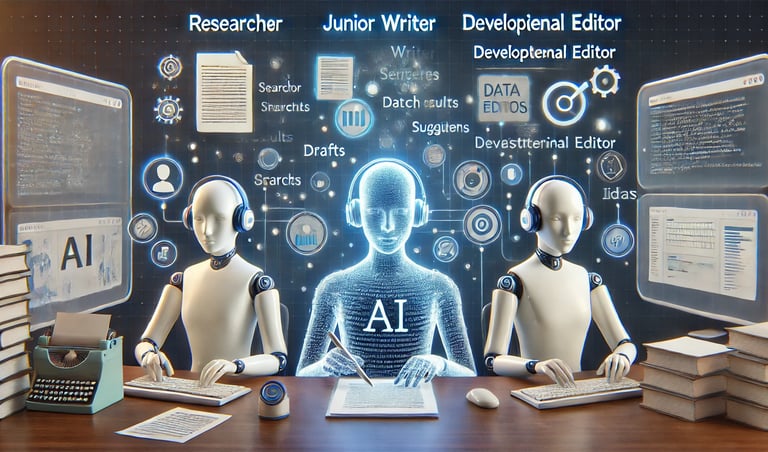AI As Your Writing Partner
Collaborating with AI for Biographical Writing: Lessons from Writing Nadene's Journey
NADENE'S JOURNEY AI WRITING
Galen Manning
2/16/20253 min read
AI as Your Writing Partner
Collaborating with AI for Biographical Writing: Lessons from Writing Nadene's Journey
When I began writing "Nadene's Journey," I planned for AI to serve as more than just a transcription tool. Like many biographers, I needed help with various aspects of the writing process - from drafting initial content to ensuring consistency across chapters. Through careful experimentation, I developed a three-tier AI partnership approach that preserved authenticity while enhancing efficiency.
Working with a Junior Writer
Just as a writing team might include junior writers to help with initial drafts, I found that Claude, an AI from Anthropic, could serve as a reliable first-draft partner. The key was to provide a prompt to be a junior writer and then include precise "beats" - detailed descriptions of what each section should cover - along with specific guidelines about style and voice. I learned the concept of the beat from testing SudoWrite, an AI writing tool mainly focused on fiction writing.
For example, when writing about Nadene's theater experiences, I would use AI assistive storytelling using beats for sections like "Set the stage: Open with a vivid, theatrical description of what drew Nadene to community theater" and "Behind the scenes: Dramatically recount how Nadene became a founding member of the Guymon community theater." By treating Claude as a junior writer who needed to align with my writing style, I maintained control over the narrative while benefiting from AI assistance with initial drafts.
Check out my Junior writer prompt to Claude including specific style guidelines for Nadene's Journey:
Nostalgic and reflective tone
Focus on resilience
Blend of past tense with occasional present tense moments
Straightforward vocabulary with varied sentence structure
Rich sensory descriptions
Most importantly, I established a strict rule: when quoting Nadene, only her exact words could be used. This preserved the authenticity of her voice while allowing AI to help craft the surrounding narrative.
Partnering with an AI Developmental Editor
As a first-time author, I discovered that understanding the various roles in book editing - developmental editors, copy editors, typesetters – from Reedsy. I leveraged multiple AI tools (ChatGPT, Claude, and Perplexity) to research and define a comprehensive developmental editing process. This resulted in a robust set of AI Prompts for developmental editing:
Initial Review & Preparation
Big Picture Review
Detailed Manuscript Analysis
Feedback & Author Communication
Ongoing Collaboration
Final Review & Manuscript Preparation
The heart of this process lies in phases two and three. For the Big Picture Review, I created specific prompts for Claude to evaluate:
Structure and organization
Narrative focus and theme development
Pacing and reader engagement
Historical accuracy and fact-checking
The Detailed Manuscript Analysis involved even more specific prompts, examining:
Writing style and tone consistency
Narrative cohesion
Dialogue and quotation effectiveness
Proper resolution and theme closure
This systematic approach led to significant improvements. For instance, I had initially separated Nadene's time in Guymon into three distinct sections: career, family life, and community theater. Through AI-assisted review, I recognized that combining her career and family life narratives would create a more cohesive story, reducing length while better highlighting how these aspects of Nadene's life intertwined.
Leveraging AI for Research
The third tier of AI partnership involved using Perplexity as a research assistant. While maintaining strict verification of all facts, I found that AI could help:
Identify relevant historical context for Nadene's stories
Suggest connections between different periods of her life
Flag potential areas needing additional verification
Generate questions for follow-up interviews
Maintaining Authenticity
Throughout this process, one principle remained paramount: AI serves as a partner, not a replacement for human judgment. My initial attempts with ChatGPT revealed its limitations - it struggled to maintain context with the 70,000+ word transcript and would sometimes fabricate childhood stories. Switching to Claude proved more successful, as it could maintain context across the entire transcript and effectively combine quotes to support the narrative. Even then, I remained vigilant about discarding duplicated AI-generated fluff that didn't progress Nadene’s story.
Getting Started with AI Writing Partners
If you're considering using AI in your biographical writing, here's how to begin:
Start with clear guidelines about voice and style
Provide detailed "beats" for each section
Establish strict rules about using direct quotes
Create specific prompts for different editing phases
Maintain final authority over all content decisions
Verify all AI-suggested historical context
Remember: AI tools should enhance, not override, your voice as a writer. Used thoughtfully, they can free you to focus on the most crucial aspect of biographical writing - capturing and preserving authentic human stories.
Just as Nadene adapted to new challenges throughout her life, modern biographers can adapt to new tools while maintaining the integrity of their subjects' stories. The key lies in viewing AI as a collaborative partner rather than a replacement for human understanding and judgment.


